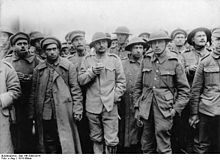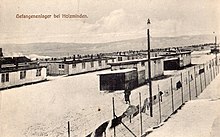This article has multiple issues. Please help improve it or discuss these issues on the talk page . (Learn how and when to remove these messages)
|

During World War I, German prisoner-of-war camps were run by the 25 Army Corps Districts into which Germany was divided. [1] [2] Around 2.4 million men were World War I prisoners of war in Germany.
Contents
- Types of camp
- List of camps by Army Corps districts
- Guards Corps (Berlin)
- I Army Corps (Königsberg)
- II Army Corps (Stettin)
- III Army Corps (Berlin)
- IV Army Corps (Magdeburg)
- V Army Corps (Posen)
- VI Army Corps (Breslau)
- VII Army Corps (Münster)
- VIII Army Corps (Coblenz)
- IX Army Corps (Altona)
- X Army Corps (Hannover)
- XI Army Corps (Cassel)
- XII Army Corps (Dresden)
- XIII Army Corps (Stuttgart)
- XIV Army Corps (Karlsruhe)
- XV Army Corps (Strasbourg)
- XVI Army Corps (Metz)
- XVII Army Corps (Danzig)
- XVIII Army Corps (Frankfurt-am-Main)
- XIX Army Corps (Leipzig)
- XX Army Corps (Allenstein)
- XXI Army Corps (Saarbrücken)
- I Royal Bavarian Army Corps (Munich)
- II Royal Bavarian Army Corps (Würzburg)
- III Royal Bavarian Army Corps (Nürnberg)
- Others
- Fictional prison camps
- See also
- References








